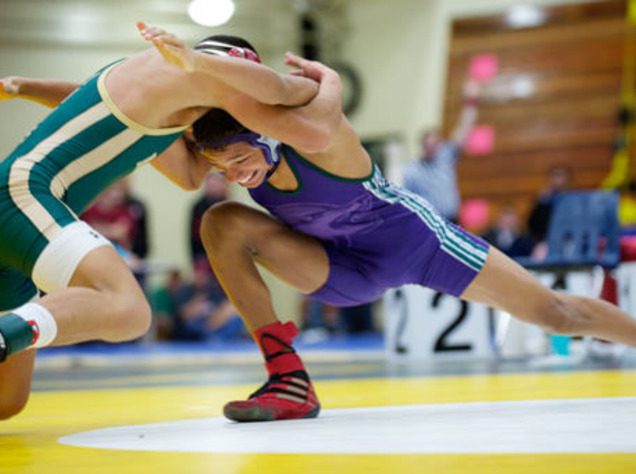Wrestling is an intense sport that requires physical strength, endurance, and a strong sense of willpower. Practicing wrestling from a young age can teach aggressiveness as well as improve strength and endurance. Although wrestling isn’t exactly a team sport in the more traditional sense like baseball and soccer, the individual nature of competing on a wrestling team can be very rewarding. The sense of personal responsibility for the outcome of your match can be a great motivational tool.
For a newcomer, however, getting into wrestling can be beyond intimidating. Besides the insane physical demand, strategy, and regimen, the rules can be a little complex to wrap your mind around initially. But with some serious dedication, focus, and CoachUp’s handy guide to the sport, you’ll be pinning people in no time.

OBJECTIVE
A wrestling match can be won in two different ways and the first of which is to pin your opponent, seems simple, right? Wrong. This means pressing your opponent’s back or shoulder blades to the mat for a minimum of two seconds. If you pin your opponent, the wrestling match is automatically over. The second way to win is to outscore your opponent after the end of three timed periods.
These periods are almost universally applied across high school and collegiate wrestling matches. However, their length will differ according to the level of the competition. In youth wrestling, the time periods are normally just one minute each, while the high school level is generally two minutes. In collegiate wrestling, the first period is three minutes while the second and third are just two minutes.
SCORING
There are several ways you can earn points during a wrestling match, so use them all to your advantage. Needless to say, there are plenty of ways to score and many of them come while on the defensive front. So, just because you may be outmatched or exhausted, it doesn’t mean you have to recklessly throw yourself at the opposition and hope for the best. No, in fact, therein lies most of the strategies behind wrestling — are you a constant attacking? Or do you constantly wait for the right moment to pursue a pin? The choice is yours, you just must decide and hone your point of attack, carving out a reliable, personal, and unique form of wrestling! Here is a breakdown of scoring moves:
- Takedown — 2 Points: A takedown is awarded when you take your opponent down to the mat and control him or her.
- Escape — 1 Point: An escape is awarded when you escape out of your opponent’s controlling position to a neutral or attacking position
- Reversal — 2 Points: A reversal is awarded when you escape your opponent’s controlling position and get your opponent in a controlled position.
- Near Fall — 2 or 3 Points: A near fall is awarded when you have your opponent nearly pinned. This means their shoulders or back is within 5 inches of the ground for at least 2 seconds. Two points are awarded for two seconds in this position and three points are awarded once that position is held past five seconds.
PENALTIES
But, of course, what good sport exists without penalty and punishment? For every honest, good-intentioned, rule-abiding wrestler out there, you won’t be surprised to know that there are just as many that will skirt the rules for any sort of advantage. Sometimes this is intentionally done, in hope that the official doesn’t notice, but, sometimes it’s an accident as well. Hopefully, you can use these definitions to avoid committing any penalties that either carry point deductions or potential ejection from the match.
- Illegal Hold: There are several illegal holds that will earn you a penalty deduction of 1 point for every time you use it. Some prominent examples include twisting the arm in a lock above a 90 degree angle or a headlock above the elbow.
- Technical Violation: There are a few different technical violations in wrestling including, but not limited to, going off the mat, stalling, and grabbing the clothing or headgear of the opponent.
- Unnecessary Roughness: This is defined by any act that is hazardous to an opponent’s well-being.
- Unsportsmanlike Conduct: Unsportsmanlike behavior is addressed differently depending on if it is during or after the match. If it’s during the match, the wrestler will be warned and possibly deducted one point. If after, the wrestler’s team will lose one point for their team.
- Flagrant Misconduct: Any misconduct deemed flagrant will result in automatic ejection from the match and a deduction of three team points.
(Related: read about four moves every wrestler should know here.)
Huddle Up
Wrestling is a complex sport and there are many more technicalities involved than those listed here. The strategy behind wrestling goes far beyond anything that could be listed in one article. If you want to learn more about the sport of wrestling, be sure to check out the rest of our wrestling articles and coaching resources. The purpose of this article was to give a general outline of the sport and its demanding nature — but if you’re still interested in learning more, you don’t have to stop here.
Consider booking one of CoachUp’s private trainers to take your wrestling game to the next level. Our expert team has decades of wrestling experience and they’d love to bestow some of their wisdom on the next generation of winning wrestlers — what are you waiting for?
Be prepared for the biggest moments by mastering the small ones off the mat.
How useful was this post?
Click on a star to rate it!
Average rating 4.6 / 5. Vote count: 13
No votes so far! Be the first to rate this post.




One Response
my gf is making me learn. this is extremly confusing. thanks tho